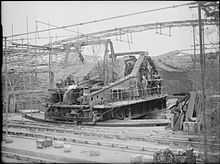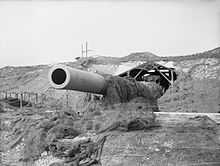BL 14 inch Mk VII naval gun
| BL 14 inch Mark VII | |
|---|---|
|
Gunners and forward turrets of HMS Duke of York after the Battle of North Cape | |
| Type | Naval gun |
| Place of origin | UK |
| Service history | |
| In service | 1940-1945 |
| Used by | UK |
| Production history | |
| Designed | 1937 |
| Number built | 78 |
| Specifications | |
| Weight | 80.26 metric tons (176,900 lb) |
| Barrel length | 53 ft 6 in (16.31 m) bore (45 calibres) |
|
| |
| Shell | 1,590 lb (720 kg) |
| Calibre | 14 inches (360 mm) |
| Elevation |
Naval: 40° Coastal: 45° |
| Rate of fire | 2 rounds per minute |
| Muzzle velocity | Standard Charge: 2,400 ft/s (730 m/s) (25% wear), 2,483 ft/s (757 m/s) (new gun)[1] |
| Maximum firing range | 36,500 yd (33,400 m) at 40.7° (25% wear) or 38,600 yd (35,300 m) at 40° with new linings |
The BL 14 inch Mk VII naval gun[2] was designed for the battleships of the Royal Navy in the late 1930s. This gun armed the King George V-class battleships during the Second World War.
Background
The choice of calibre was limited by the Second London Naval Treaty, an extension of the Washington Naval Treaty which set limits on the size armament and number of battleships constructed by the major powers. After disappointing experiences with the combination of high velocity but relatively light shell in the BL 16 inch /45 naval gun of the Nelson-class battleships, the British reverted to the combination of lower velocities and (relatively) heavier shells in this weapon.
Design
These built-up guns were constructed using a non wire wound radial expansion design which was an advance on previous British practice with a longer barrel life and better accuracy. Unfortunately, the choice of mountings was for quadruple turrets and in practice these developed a reputation for unreliability, with the turrets jamming during battle. However, it has been argued that these jams were typically caused by errors in drill, either due to lack of gun crew training, as was the case when the newly commissioned HMS Prince of Wales engaged the Bismarck in the Battle of the Denmark Strait (1941), or due to crew fatigue resulting from the prolonged nature of the engagement, as was the case when HMS King George V engaged Bismarck in 1941 and HMS Duke of York engaged Scharnhorst in the Battle of North Cape (1943).
Coastal guns
Main article Cross-Channel guns in the Second World War.


Two guns, nicknamed Winnie and Pooh, were also mounted in World War II as coastal artillery near Dover to engage German batteries across the Channel in occupied France.
Armour penetration
- Penetration: belt 668 mm/0 m; 396 mm/9,144 m; 335 mm/13,716 m; 285 mm/22,860 m; decks 29 mm/9,144 m; 50 mm/13,716 m; 73 mm/18,288 m; 102 mm/22,860 m; 121 mm/25,603 m(4.74 in/28,000 yards)
Surviving example
-
On display at Fort Nelson -

Breech detail
See also
Notes
- ↑ With 338.3 lb (153.5 kg) cordite.
- ↑ Mk VII = Mark 7. Britain used Roman numerals to denote Marks (models) of ordnance until after World War II. This was the seventh model of BL 14-inch naval gun.
References
External links
| Wikimedia Commons has media related to BL 14 inch Mk VII naval gun. |
- Video : "Winnie" firing, Dover, 1941
- Movie clip of RN 14" gun loading and firing procedure (NOTE : external sequences are of different guns)
| ||||||||||||||||||||||||||||||||||||||||||||||||||

